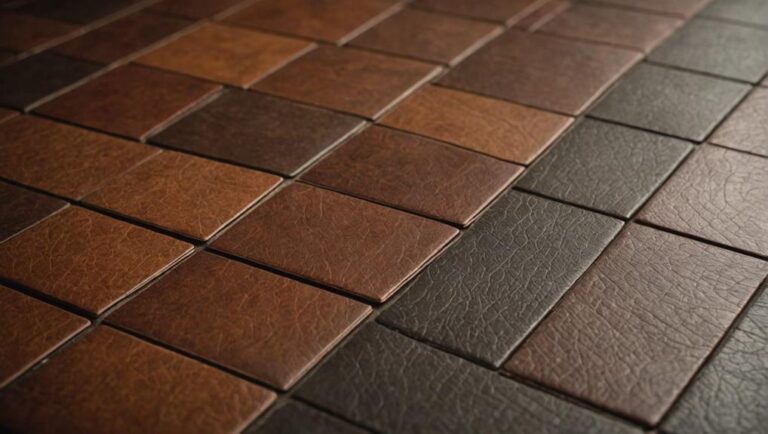To fix minor floor damage before moving out, start by evaluating the damage to identify scratches, dents, or stains. Clean the affected area thoroughly using suitable cleaning products. For scratches, use wood filler or a wax crayon, and steam out dents with a damp cloth and a hot iron. Tackle stains by matching the removal method to the stain type, using mild soap or vinegar as needed. Finally, touch up the paint or finish to blend in repairs seamlessly. By following these steps, you'll be well on your way to restoring your floors, and there's more you can explore for a thorough approach.
Assessing the Damage
Before diving into repairs, you'll want to thoroughly assess the damage to your floor. A proper damage evaluation is key to determining what needs fixing. Start with a visual inspection of the entire area. Look closely for scratches, dents, or stains that could indicate deeper issues. Pay attention to any warping or buckling, as these can signal moisture problems or structural concerns that require immediate attention.
While conducting your visual inspection, take note of the floor type—hardwood, laminate, tile, or carpet—as this will influence your repair methods. If you spot any soft spots or areas that feel uneven, these could be signs of underlying damage and should be addressed before proceeding. Document your findings; taking photos can help you track the extent of the damage and assist in your repair planning.
Cleaning the Affected Area
Once you've assessed the damage, it's time to focus on cleaning the affected area. A clean space not only helps you see the damage clearly but also prepares the floor for any necessary repairs. Start by gathering appropriate cleaning products that are safe for your flooring type. Always read the labels to guarantee compatibility.
Here are some effective cleaning techniques you can use:
| Cleaning Technique | Recommended Products | Safety Tips |
|---|---|---|
| Dusting | Microfiber cloth | Wear a dust mask |
| Mopping | Mild detergent or vinegar | Use warm water |
| Spot Cleaning | All-purpose cleaner | Test in a small area first |
| Scrubbing | Soft-bristle brush | Use light pressure |
| Drying | Clean, dry towels | Verify no moisture left |
Start by dusting the area to remove loose dirt and debris. Next, mop using a mild detergent mixed with warm water, or for a natural option, use a vinegar solution. If you encounter stubborn stains, use a soft-bristle brush with the all-purpose cleaner, but apply gentle pressure to avoid scratching the surface.
After cleaning, make certain the area is thoroughly dried with clean towels. This will prevent moisture from settling into any cracks or crevices, which could lead to further damage. By following these cleaning techniques with the right products, you guarantee the floor is ready for the next steps in addressing the damage.
Repairing Scratches and Dents
Repairing scratches and dents in your flooring can often be a straightforward process that restores its original appearance. First, assess the damage to determine the best approach for scratch repair or dent removal. For minor scratches on hardwood or laminate floors, you can use a wood filler or a wax crayon that matches your flooring color. Simply apply the filler to the scratch, let it dry, and then buff it with a soft cloth to blend it in.
If you're dealing with deeper scratches, sanding may be necessary. Carefully sand the scratched area with fine-grit sandpaper, being cautious not to damage the surrounding floor. Once sanded, clean the surface and apply a matching stain or finish. Allow it to dry completely before walking on it.
For dents, the approach varies depending on the flooring type. In hardwood floors, you can often remove dents by applying a damp cloth over the area and using a hot iron to create steam. The steam helps the wood fibers expand, reducing the dent. Be sure to keep the iron moving to avoid burns.
In laminate flooring, dent removal can be trickier. If the dent is small, using a laminate floor repair kit can help fill in the damaged area. Always follow the manufacturer's instructions for the best results.
Removing Stains Effectively
Even after addressing scratches and dents, your floors might still face challenges like stubborn stains. Removing these stains effectively is vital for maintaining the appearance of your flooring, especially before moving out. Here are some practical stain removal techniques that you can easily implement.
First, identify the type of stain you're dealing with. For food or beverage spills, a simple solution of warm water and mild dish soap can work wonders. Just dampen a soft cloth with the mixture and gently blot the stain—never rub, as this can spread it further.
For tougher stains like ink or grease, consider using eco-friendly solutions. White vinegar mixed with water is an excellent option. Apply the solution to the stain, let it sit for a few minutes, and then blot it away with a clean cloth. Always test any cleaning solution on a small, inconspicuous area first to make sure it won't damage your floor.
Another effective method is using baking soda. Create a paste with water, apply it to the stain, and let it sit for several minutes before wiping it away. Baking soda is a gentle abrasive that can lift stains without harming the floor's finish.
If all else fails, you might want to consult a professional cleaner who specializes in eco-friendly products. This way, you can guarantee the safety of both your floors and the environment. By using these stain removal techniques, you'll leave your floors looking fresh and clean for the next occupants.
Touching Up Paint or Finish
When it comes to touching up paint or finish on your floor, the first step is to assess the damage to determine the best course of action. You'll need to choose the right paint or finish that matches your flooring. Finally, using proper application techniques will guarantee a seamless repair that blends well with the surrounding area.
Assessing the Damage
Before diving into any repairs, it is essential to evaluate the damage to your floor's finish or paint. Understanding the damage types will help you determine what needs fixing and how to proceed safely. Use the right inspection tools to guarantee you get an accurate evaluation. Here's what to look for:
- Scratches: Check for surface scratches that may only need a touch-up.
- Dents: Identify any dents that might require more extensive repairs.
- Discoloration: Look for areas where the finish has faded or changed color.
- Peeling Paint: Inspect for any paint that's lifting or peeling away.
Once you've identified the types of damage, take note of the severity. Minor scratches might just need a little paint, while deeper dents could require sanding or refinishing. Always prioritize safety by wearing protective gear and making certain your workspace is well-ventilated. By thoroughly evaluating the damage, you'll be better prepared to tackle the repairs effectively and maintain the integrity of your floor before moving out.
Choosing the Right Paint
Choosing the right paint for touching up your floor's finish is important, especially if you want the repairs to blend seamlessly with the existing surface. Start by identifying the current color and finish of your floor. This step is essential for effective color matching. If you're unsure, take a small sample or use a color-matching tool from your local hardware store to guarantee accuracy.
Next, consider the various finish options available. Whether your floor has a glossy, satin, or matte finish, selecting a matching sheen is critical for the touch-up to look natural. Most stores offer samples, so you can test how the paint interacts with your floor's lighting and surroundings.
When you've found the right color and finish, verify the paint is suitable for the flooring material you're working with, whether it's wood, laminate, or tile. Always check for safety data on the paint, confirming it's free from harmful chemicals, especially if you have pets or children at home.
Application Techniques for Touch-Up
Getting started with application techniques for touch-ups is essential for achieving a professional-looking finish. To guarantee your repairs blend seamlessly, focus on color matching and use the right application tools. Here are some practical steps to follow:
- Clean the Area: Make sure the surface is free from dust and debris to guarantee the paint adheres properly.
- Prepare Your Tools: Gather brushes, rollers, or spray equipment depending on the size of the area you're touching up.
- Test the Color: Always test your matched paint on a small, inconspicuous area first to confirm it matches the existing finish.
- Apply in Thin Layers: Use light, even strokes to avoid visible brush marks and allow each layer to dry before applying another.
Replacing Damaged Flooring Sections
When you notice damaged sections in your flooring, the first step is to assess the severity of the damage. Once you know what you're dealing with, you can choose the right replacement materials that match your existing floor. Finally, you'll be ready to install the new sections and restore your floor's appearance.
Assessing Damage Severity
Evaluating the extent of your floor's damage is essential before diving into repairs, especially if you're considering replacing sections. Start by identifying common issues that may have affected your flooring. Look for:
- Scratches or dents that compromise the surface
- Water damage that may indicate a leak
- Cracks that could worsen over time
- Loose or warped boards that might affect stability
Once you've assessed the damage, it's time to determine if replacement is necessary. Comparing repair methods can help you choose the best approach for each issue. For minor scratches or dents, refinishing might suffice. However, if water damage is prevalent, replacing entire sections could be the safer option to prevent mold growth.
Always prioritize safety during your assessment. Make certain to wear protective gear, especially if you're dealing with hazardous materials. And if the damage appears extensive or structural, consult a professional to verify you're making the right decisions. By carefully evaluating the severity of the damage, you'll set yourself up for a successful repair process.
Choosing Replacement Materials
Choosing the right replacement materials for damaged flooring sections can significantly impact both the aesthetics and durability of your floor. Start by identifying the material types used in your existing flooring, whether it's hardwood, laminate, tile, or vinyl. Each type has its own characteristics, so it's essential to find a suitable match for seamless repairs.
Next, consider color matching. You'll want the new materials to blend in with the surrounding floor to avoid noticeable patches. If you're working with hardwood, bring a sample to a local store for guidance on matching stains. For laminate or vinyl, look for product lines that offer similar shades.
Don't forget to check for the same finish or texture, as this can also affect the overall appearance. If you're unsure about color or material compatibility, consult a flooring professional for advice. Selecting the right materials not only guarantees a cohesive look but also contributes to the longevity of your flooring. Ultimately, investing time in choosing the right replacement materials will provide peace of mind and enhance the safety and visual appeal of your home before moving out.
Installing New Sections
Installing new sections of flooring to replace damaged areas can seem intimidating, but with the right approach, it's a manageable task. Whether you're dealing with laminate, hardwood, or vinyl, understanding the proper installation methods is key to guaranteeing a seamless repair.
Start by gathering the necessary tools and materials. Here's what you'll need:
- Replacement flooring sections that match your existing flooring types
- A utility knife or saw for cutting
- A measuring tape for accurate sizing
- Adhesive or nails, depending on the flooring type
Begin by measuring the damaged area and cutting out the affected section carefully. Make sure your cuts are clean to avoid future issues. Next, prepare the subfloor by confirming it's dry and free of debris.
Once you've prepared the area, install the new section using the appropriate installation method—gluing down for vinyl or nailing for hardwood. Ensure everything fits snugly, and finish by sealing any gaps.
Final Inspection and Touch-ups
After completing your repairs, a thorough final inspection is essential to guarantee everything looks just right. This step is vital, especially if you're preparing for a final walkthrough with your landlord. They'll likely have specific expectations regarding the condition of the floors, so it's important to be meticulous.
Start by examining each area where you made repairs. Look for inconsistencies in color or texture that might draw attention. If you notice any touch-ups needed, grab your paint or finish and make those adjustments carefully. Remember, the goal is to blend the new repairs with the existing floor as seamlessly as possible.
Next, check for any remaining debris or dust from your repairs. A clean floor not only looks better but also shows that you respect the property. Use a broom or vacuum to remove any particles, and consider a damp mop for a polished finish.
Pay special attention to corners and edges, as these areas can often reveal signs of wear or damage that might have been overlooked. If you spot any issues, take the time to address them now.
Frequently Asked Questions
What Tools Do I Need for Minor Floor Repairs?
For minor floor repairs, you'll need some essential tools to get the job done effectively. Start with a utility knife for cutting materials, sandpaper for smoothing surfaces, and a putty knife for applying fillers. You'll also want a hammer and nails or adhesive for securing loose boards. Depending on your floor repair techniques, having a measuring tape and a level handy will guarantee accuracy and safety during your repairs.
Can I Use Household Items for Cleaning Floor Stains?
So, you've got a floor that looks like a Jackson Pollock painting, huh? Fear not! You can use household items for stain removal. Vinegar and baking soda are your cleaning solutions, ready to tackle those pesky marks. Just mix them, apply to the stain, and let it sit for a bit before wiping away. Always test in a small area first, 'cause safety's key. Who knew your kitchen could double as a cleaning lab?
How Long Does It Take to Repair Floor Damage?
Repairing floor damage can take anywhere from a few hours to a couple of days, depending on the extent of the damage and the DIY techniques you choose. Simple fixes, like filling scratches or small dents, usually require minimal time and low repair costs. However, if you're dealing with significant issues, the process might be more labor-intensive. Always prioritize safety by wearing protective gear while working on your floors.
Will My Landlord Notice Minor Floor Repairs?
Will your landlord notice minor floor repairs? It depends on several factors. If the repairs are subtle, they might not catch them, but landlord expectations can vary widely. If your repair visibility is high—like noticeable patches or mismatched flooring—they're more likely to see it. To guarantee you're safe, consider how your corrections blend in with the rest of the floor. A seamless fix could keep your deposit intact, so tread carefully.
Is It Worth Fixing Floor Damage Before Moving Out?
Is it worth fixing floor damage before moving out? It often comes down to cost vs. benefit. If the repairs are minor and inexpensive, you might avoid potential deductions from your security deposit. However, consider repair alternatives like temporary fixes or area rugs that could save you money. Weighing the total costs against the benefits of a smoother move-out process is vital for your peace of mind and safety in the long run.




